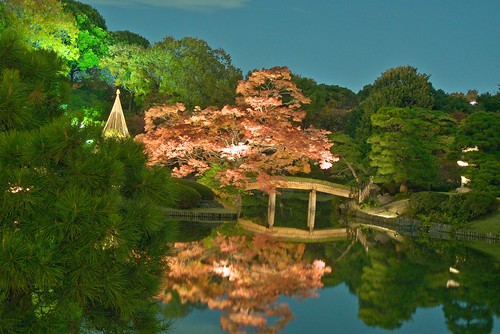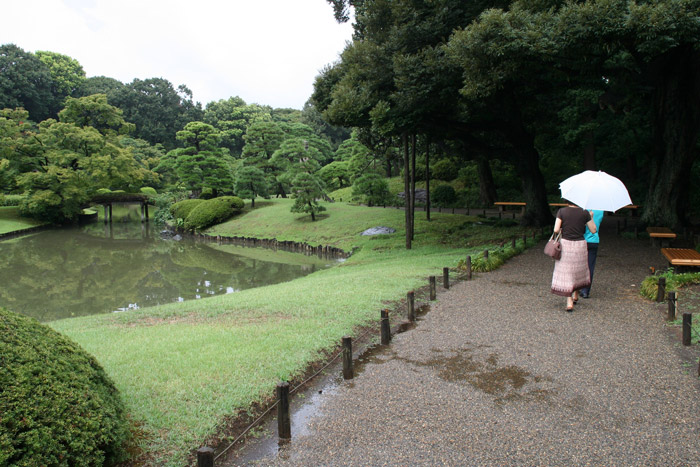Rikugi-en has been counted as one of two excellent gardens of the Edo period together with Koishikawa Koraku-en. The garden was built by Mr. Yoshiyasu Yanagisawa, a famous favorite of the fifth Shogun Tunayoshi Tokugawa , as his villa in 1702. This garden is a typical Daimyo garden called a Kaiyuu pond garden with hills and ponds. Because the land had been on a corner of the flat Musashino, he dug a pond and made hills. The name, Rikugi-en, came from "six elements of Waka poems" that had been derived from "six styles of poems" written in the old Chinese poetry book "Mao-shi". In this garden, a big pond with some islands is surrounded by trees and offering imitations of famous Japanese beautiful spots such as Wakanoura in Kishuu(Wakayama Prefecture). The garden became the property of Iwasaki family of Mitsubishi group and was contributed to Tokyo city and opened to the public in 1938. Rikugi-en was appointed as special beauty spot of Japan in 1953. Rikugien is quite a spacious garden with a central pond, islands, forested areas, man made hills and several teahouses. It takes about an hour to cover the garden's whole network of walking paths at a leisurely speed.
The Rikugien Gardens are the most famous or the best Japanese garden in Tokyo. But, it is worth visiting the northern suburbs of Tokyo if you want to see a garden whose skyline is not dominated by skyscrapers.
The journey starts off at the Deshio-no-minato, a wide clearing which stretches along half of the lake, giving you the opportunity to walk the banks and watch the landscape transform.
 In the center of the lake is the Imo-yama, a well kept island with a land bridge, which unfortunately is not open for visitors. Perfectly trimmed bushes of pink and red azalea's dot the shore and line the meandering paths (between May and July they will be in bloom).
In the center of the lake is the Imo-yama, a well kept island with a land bridge, which unfortunately is not open for visitors. Perfectly trimmed bushes of pink and red azalea's dot the shore and line the meandering paths (between May and July they will be in bloom).At the shore or any of the various bridges (there are six in total) you can peer down into the water below and watch the koi gather under you, in hopes that you'll toss in some bread for them, and if you look closely you'll also see large turtles, the size of diner plates, swimming amongst the koi.
The front entrance of the park opens onto rolling and grassy hills in front of the large central pond. But first, you walk past the large weeping cherry tree that is, of course, best viewed when the blossom are out in late March.
The shoreline area opposite the entrance is called Deshio-no-minato. As you walk around the pond, numerous nice views of the pond are revealed. Some distinct views are separated by only a few meters but show another aspect of the scenery. All paths in Rikugien pivot around the pond. The inner paths are more open, bright and sculpted and the outer paths go through woodland terrain.
If you walk clockwise around the pond then you will first encounter the Takimi-no-chaya (Takimi Teahouse) in the forest and next to a small creek. Next, the larger Fukiage-chaya (Fukiage Teahouse) overlooks the central pond on the north shore. Refreshments can be bought and enjoyed next to the water here. Tsutusuji-no-chaya to the north of Fukiage-chaya is perhaps the most modest but also the most dramatic of them all. It was built during the Meiji Period and its roof is supported by twisted old wood that absurdly holds up a roof that looks ready to crush it at any moment.
In the northern corner is Fujishiro-toge. This path is named after a mountain pass in Wakayama Prefecture. From the top, one can see the northern corner of Rikugien Gardens.
Coming back, there are a number of dramatic bridges and a leaf viewing forest. One of the bridges leads to the large island in the pond. However, the best is called Togetsukyo which was inspired by a Waka poem about the moon moving across the sky as a crane cries in a nearby rice paddy. The bridge is made up of two large stone slabs that are laid parallel to each other.
The highest point in the garden, this rolling hill stands at 35m high, giving you a tremendous panorama of the garden. Another key vantage point offering a view of the opposite shore. This spot also has a charming tea house where you can go, sit down and enjoy some green tea and for the icing on the cake, enjoy some traditional Japanese sweets as well. Of course there is a fee for this extra service, about 500 yen. The garden is designed to give a maximum impression of space, but still maintain enough wooded areas and back trails to give a feeling of intimacy.
The entrance to Rikugien Gardens is not particularly close to any station. The Komagome Stations on JR's Yamanote Line and Tokyo Metro's Namboku Line are both recommended and are to the north of the Rikugien Gardens. It will take around 10 minutes to reach it by walking from either of the Komagome Stations. To the south, Sengoku Station on the Toei Mita Line is a bit farther from the gardens. Guide services are provided (Japanese only) at 11:00 am and 2:00 pm on Sundays and holidays. If you're looking for a challenge then try to find all 32 "Sekichu" markers (originally 88) that indicate places to where you can see the special views of the garden.
Hours:9:00 to 17:00 (entry until 16:30)
Closed:December 29 to January 1
Admission:300 yen




No comments:
Post a Comment